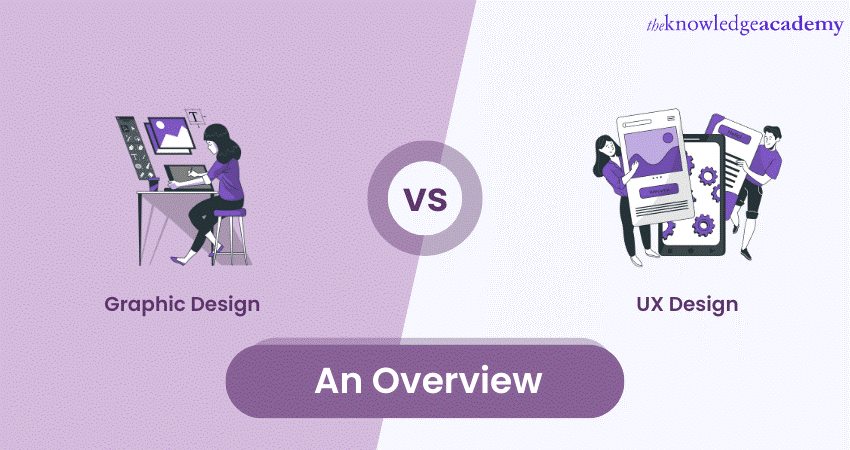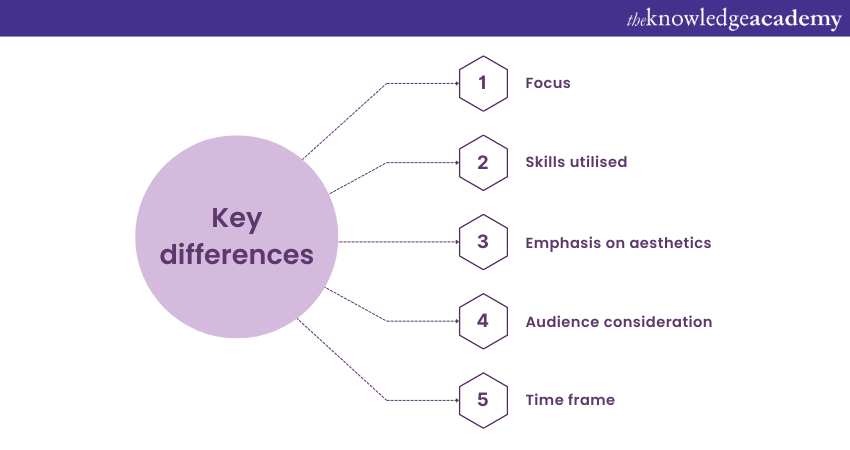We may not have the course you’re looking for. If you enquire or give us a call on 01344 203999 and speak to our training experts, we may still be able to help with your training requirements.
Training Outcomes Within Your Budget!
We ensure quality, budget-alignment, and timely delivery by our expert instructors.

Graphic Design and UX Design are distinct disciplines with unique focus and objectives. While both aim to create captivating visual experiences, they cater to different aspects of design. Graphic Design involves crafting visually appealing and communicative elements like logos, illustrations, and layouts. On the other hand, UX Design revolves around understanding user behaviours and optimising digital products for seamless, user-centric experiences.
This blog on Graphic Design vs UX Design will explore the fundamental differences between Graphic and UX Design, shedding light on their contributions to the ever-evolving design landscape.
Table of Contents
1) Introduction to Graphic Design vs UX Design
2) Key differences
a) Focus
b) Skills utilised
c) Emphasis on aesthetics
d) Audience consideration
e) Time frame
f) Collaboration
3) Conclusion
Introduction to Graphic Design vs UX Design
Graphic Designers are experts in creating visually appealing and communicative elements such as logos, posters, advertisements, and website layouts. They use their artistic skills to evoke emotions, convey messages, and establish brand identities.
On the other hand, UX Design, short for User Experience design, centres around understanding the end-users and their interactions with products or digital platforms. UX Designers conduct extensive research to gain insights into user behaviours, needs, and pain points.
Based on this research, they craft intuitive and user-friendly experiences, ensuring that products are easy to use, efficient, and enjoyable for the target audience.
Key differences
Following are the key differences between Graphic Design and UX Design:

Focus
The focus is a fundamental difference that sets apart Graphic Design and UX Design, outlining their core areas of emphasis in the design process.
Graphic Design: The primary focus of Graphic Design is creating visually compelling and communicative elements. Graphic Designers are skilled in using various design tools and artistic techniques to craft eye-catching designs that evoke emotions, convey messages, and establish strong brand identities.
They use colours, typography, imagery, and layout to create visually engaging materials such as logos, posters, brochures, advertisements, and website designs. The Graphic Design aims to captivate audiences, create a positive visual impact, and effectively communicate the intended message.
UX Design: In contrast, UX Design focuses on user experiences and interactions with digital products. UX Designers prioritise understanding the target audience's needs, behaviours, and preferences through thorough user research and testing. They aim to create user-friendly, intuitive, and seamless experiences catering to users' requirements.
UX Designers employ techniques like information architecture, user flows, and wireframing to optimise the usability and functionality of websites, applications, and other digital interfaces.
Learn to create strategies for user experience, sign up for User Experience (UX) Masterclass Course now!
Skills utilised
The skills utilised in Graphic Design and UX Design are distinct and reflect the unique demands of each discipline in the design process.
Graphic Design: Graphic Designers use various artistic and design-related skills to create visually compelling and communicative elements. They possess a keen eye for aesthetics and an understanding of colour theory, enabling them to craft harmonious and visually appealing designs.
Proficiency in using design software like Adobe Illustrator, Photoshop, and InDesign is essential for creating and manipulating graphics, illustrations, and layouts. Graphic Designers also excel in typography, selecting and arranging fonts to convey the right tone and message.
Their skills extend to crafting engaging visual narratives, understanding composition, and ensuring the design aligns with the brand's identity and objectives. Additionally, strong communication skills are vital, as Graphic Designers collaborate with clients and stakeholders to understand their vision and deliver compelling design solutions.
UX Design: In contrast, UX Designers leverage diverse skills, primarily centred around understanding user needs and creating seamless experiences. Research skills are fundamental, as UX Designers conduct user interviews, surveys, and usability testing to gather valuable insights into user behaviours and preferences.
Information architecture skills come into play when structuring the content and layout of digital interfaces to facilitate easy navigation. Proficiency in wireframing and prototyping tools allows UX Designers to create interactive mock-ups, allowing for iterative design improvements.
Interaction design skills help UX Designers craft intuitive, user-friendly interactions that streamline user tasks. Moreover, a deep understanding of user psychology and human-computer interaction is crucial for designing interfaces that meet users' cognitive and emotional needs.
Enhance your skills in App and Web development, sign up for App & Web Development Training now!
Emphasis on aesthetics
The emphasis on aesthetics significantly differs between graphic and UX Design, reflecting their distinct priorities in the design process.
Graphic Design: Graphic Designers strongly emphasise aesthetics and visual appeal. Their expertise lies in using colours, typography, imagery, and layout to create visually striking and impactful designs.
Aesthetics are crucial in capturing audiences' attention and evoking emotions that align with the intended message or brand identity. Graphic Designers carefully select colour palettes to create harmonious, eye-catching visuals that resonate with the target audience. They curate typography to convey the right tone and personality, ensuring the design communicates effectively.
Additionally, Graphic Designers pay meticulous attention to the arrangement of elements, creating balanced and visually pleasing compositions. The goal of emphasising aesthetics in Graphic Design is to create memorable and compelling visuals that leave a lasting impression.
UX Design: While aesthetics are still important in UX Design, the emphasis shifts toward functionality and usability. UX Designers prioritise creating intuitive and user-friendly experiences, ensuring users can easily and efficiently navigate digital interfaces.
While aesthetics contributes to the overall user experience, the primary focus is optimising the layout and interaction design to facilitate seamless user interactions. UX Designers aim to eliminate unnecessary clutter and distractions, guiding users through clear and intuitive pathways to accomplish their goals.
The emphasis on usability and functionality ensures that the design aligns with user expectations and objectives, ultimately improving user satisfaction.
Audience consideration
Audience consideration is a critical aspect that sets apart Graphic Design and UX Design, reflecting their unique approaches to understanding and catering to the needs of their target users.
Graphic Design: In Graphic Design, audience consideration revolves around understanding the preferences, tastes, and emotions of the target audience. Graphic Designers conduct research to gain insights into the intended viewers' demographics, interests, and cultural backgrounds.
By understanding the audience's preferences, Graphic Designers can create designs that resonate with them, evoke emotions, and leave a lasting impact.
For example, when designing a marketing campaign, Graphic Designers tailor visuals and messaging to appeal to the specific tastes and preferences of the target market. Audience consideration in Graphic Design ensures that the design effectively communicates the intended message and establishes a strong connection with the viewers.
UX Design: In contrast, audience consideration in UX Design is focused on understanding the behaviours, needs, and pain points of the end-users who will interact with digital products or interfaces. UX Designers conduct in-depth user research through interviews, surveys, and usability testing to gather insights into how users interact with the product and what challenges they may face.
For instance, when designing a mobile app, UX Designers prioritise placing essential features and streamlining user flows to ensure a smooth and intuitive experience. Audience consideration in UX Design ensures that the final product addresses users' needs and delivers a seamless and satisfying experience.

Time frame
The time frame represents a difference between Graphic Design and UX Design, reflecting the varying durations of the design process in each discipline.
Graphic Design: Graphic Design projects often have relatively shorter time frames, especially for creating standalone visual assets like posters, logos, and advertisements. Once the design brief and requirements are clear, Graphic Designers can efficiently execute their creative vision using design software and artistic techniques.
They can produce visually appealing designs within shorter turnaround times, making Graphic Design suitable for projects with immediate deadlines or rapid design iterations.
UX Design: Conversely, UX Design projects may involve more extended time frames, particularly during the user research and testing phases. Conducting thorough user research, gathering insights, and iterating on designs based on user feedback can be time-consuming but essential for creating compelling user experiences. The complexity of digital interfaces and the need for comprehensive user testing may extend the overall development cycle.
Collaboration
Collaboration is a significant aspect that distinguishes Graphic Design from UX Design, highlighting the different stakeholders and disciplines involved in each design process.
Graphic Design: Graphic Designers typically collaborate with marketing teams, brand managers, and clients to align their designs with the overall brand strategy and messaging. They work closely with marketers to understand the target audience and tailor their designs to appeal to specific market segments.
Collaboration with brand managers ensures the design aligns with the brand's identity and values, maintaining brand consistency across all visual materials. Graphic Designers also communicate directly with clients, understanding their vision and incorporating feedback throughout the design process.
UX Design: In contrast, UX Designers collaborate with a diverse range of stakeholders to create user-centric digital experiences. They work closely with product managers, developers, and usability experts to align the design with technical feasibility and overall product goals.
Collaboration with product managers helps UX Designers understand the product's objectives and the target market's needs. Working with developers ensures the design is implemented correctly and meets technical constraints. Usability experts provide valuable feedback through user testing, helping UX Designers identify areas of improvement and refine the design iteratively.
Conclusion
In this Blog on Graphic Design vs UX Design, we understood their distinctive roles in the design landscape. While Graphic Design prioritises visually compelling and communicative elements, UX Design focuses on creating user-centric and seamless digital experiences.
Both disciplines contribute crucially to the success of design projects, with Graphic Design captivating audiences and conveying messages through aesthetics and UX Design ensuring optimal usability and user satisfaction.
Drive user engagement, boost conversions, and create intuitive digital experiences, sign up for UX / UI Design Jumpstart Training now!
Frequently Asked Questions
Upcoming Programming & DevOps Resources Batches & Dates
Date
 UX Design Course
UX Design Course
Thu 23rd Jan 2025
Thu 20th Mar 2025
Thu 22nd May 2025
Thu 17th Jul 2025
Thu 18th Sep 2025
Thu 20th Nov 2025







 Top Rated Course
Top Rated Course


 If you wish to make any changes to your course, please
If you wish to make any changes to your course, please


